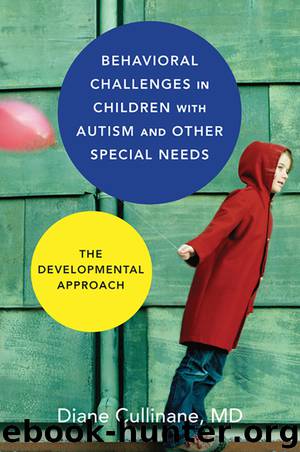Behavioral Challenges in Children with Autism and Other Special Needs by Diane Cullinane

Author:Diane Cullinane
Language: eng
Format: epub
Publisher: W. W. Norton & Company
Helping a Parent First
Ideally, a clinician would coach a parent to interact with a child in the moment of distress. However, the clinician will first need to attend to the parent’s emotional state. Misbehavior evokes emotional reactions in a parent, which may include anxiety, embarrassment, anger, and discouragement. During a challenging behavior, a clinician may begin by calming and supporting the parent before attending to the child. Or the professional may need to support both parent and child simultaneously.
Nathan was told he could not play with a particular fragile object. He sat on the floor and screamed in distress. His mother initially tried to talk with him, but he continued to wail loudly. Eventually she resigned herself to simply sitting on the couch, watching and feeling hopeless. Nathan’s screaming was loud and alarming, yet he was sitting and not causing any harm.
In this scenario, Nathan could be 2 years old or 12. The goal is the same: for Nathan to learn to tolerate disappointment and bring his highest developmental capacities to bear on the problem. He does not yet know how to independently calm himself. If the clinician can help the mother to fulfill this role, she will be learning how to help her son, and they will be building their relationship.
The clinician sat on the couch next to Mom and said, “This is really hard. I think you can help Nathan calm down. You are really the most important person to him, and he needs your help.” The clinician continued, “What usually helps Nathan?” Mom says, “I just let him cry and eventually he stops.” “Is there anything you do together that he likes?” “Sometimes I give him my phone.” “Is there anything else that you do together?” “Sometimes he lets me rub his back.” “Okay, let’s try that.”
Mom then sat by Nathan, and the clinician sat nearby. The clinician encouraged her, saying, “Nathan, Mom is here to help.” The clinician also supported the interaction by humming a little tune in rhythm with her strokes. Nathan’s sounds gradually abated, and he then leaned into Mom and looked at her.
The clinician’s calm presence, voice, and affect helped both parent and child to be soothed. Through this experience, Nathan and his mother learned that they could stay connected. Mom was able to help Nathan to move from unregulated distress to becoming calm and gaining shared attention and warmth. With practice, Nathan will learn to anticipate this help from his mom, and will be able to seek it out and avoid episodes where he feels detached and alone, with overwhelming distress.
In other moments, a clinician may coach a parent while simultaneously helping to calm and contain a child.
Jack had a difficult day at school. He arrived in the therapy room, and when a preferred toy was not where he expected, he started to grab anything within reach and fling it across the room. Dad reached his arms around Jack and held him gently yet firmly.
Sometimes, an adult must act immediately. Fortunately, the father felt empowered to act and did not wait for the clinician.
Download
This site does not store any files on its server. We only index and link to content provided by other sites. Please contact the content providers to delete copyright contents if any and email us, we'll remove relevant links or contents immediately.
Periodization Training for Sports by Tudor Bompa(8171)
Why We Sleep: Unlocking the Power of Sleep and Dreams by Matthew Walker(6618)
Paper Towns by Green John(5092)
The Immortal Life of Henrietta Lacks by Rebecca Skloot(4526)
The Sports Rules Book by Human Kinetics(4296)
Dynamic Alignment Through Imagery by Eric Franklin(4118)
ACSM's Complete Guide to Fitness & Health by ACSM(3989)
Kaplan MCAT Organic Chemistry Review: Created for MCAT 2015 (Kaplan Test Prep) by Kaplan(3940)
Introduction to Kinesiology by Shirl J. Hoffman(3726)
Livewired by David Eagleman(3685)
The Death of the Heart by Elizabeth Bowen(3553)
The River of Consciousness by Oliver Sacks(3542)
Alchemy and Alchemists by C. J. S. Thompson(3451)
Bad Pharma by Ben Goldacre(3357)
Descartes' Error by Antonio Damasio(3230)
The Emperor of All Maladies: A Biography of Cancer by Siddhartha Mukherjee(3068)
The Gene: An Intimate History by Siddhartha Mukherjee(3048)
The Fate of Rome: Climate, Disease, and the End of an Empire (The Princeton History of the Ancient World) by Kyle Harper(3003)
Kaplan MCAT Behavioral Sciences Review: Created for MCAT 2015 (Kaplan Test Prep) by Kaplan(2941)
